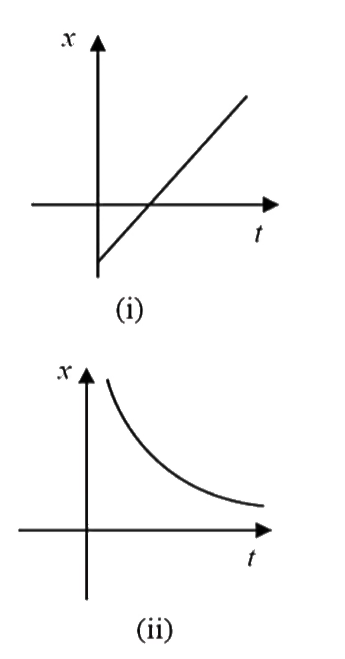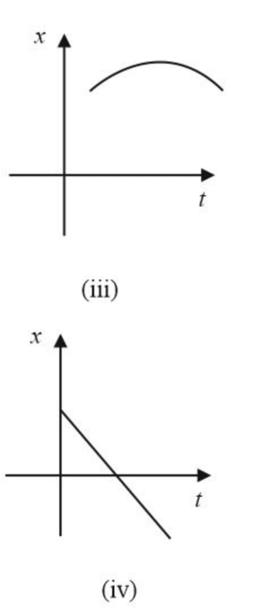A particle moves with uniform velocity. Which of the following statements about the motion of the particle is true?
Its speed is zero.
Its acceleration is zero.
Its acceleration is opposite to the velocity.
Its speed may be variable.
The correct Answer is:B
To determine which statement about the motion of a particle moving with uniform velocity is true, we can analyze the definitions and characteristics of uniform velocity.
1. Definition of Uniform Velocity:
- A particle is said to be moving with uniform velocity if it covers equal displacements in equal intervals of time.
- This implies that both the speed and direction of the particle remain constant.
2. Understanding Acceleration:
- Acceleration is defined as the change in velocity over time. Mathematically, it is expressed as:
a=ΔvΔt
- Since the velocity is constant (uniform), there is no change in velocity, which means:
Δv=0⇒a=0
- Therefore, the acceleration of the particle is zero.
3. Evaluating the Statements:
- Statement 1: "Its speed is zero."
- This is incorrect because uniform velocity means the particle has a constant speed, which is not necessarily zero.
- Statement 2: "Acceleration is zero."
- This is correct, as derived above.
- Statement 3: "Acceleration is opposite to the velocity."
- This is incorrect because the acceleration is zero, and thus there is no direction to oppose.
- Statement 4: "Speed may be variable."
- This is incorrect since uniform velocity implies constant speed.
4. Conclusion:
- The only true statement about the motion of the particle moving with uniform velocity is that acceleration is zero.
Final Answer:
The correct statement is: Acceleration is zero.
- A particle is said to be moving with uniform velocity if it covers equal displacements in equal intervals of time.
- This implies that both the speed and direction of the particle remain constant.
- Acceleration is defined as the change in velocity over time. Mathematically, it is expressed as:
a=ΔvΔt
- Since the velocity is constant (uniform), there is no change in velocity, which means:
Δv=0⇒a=0
- Therefore, the acceleration of the particle is zero.
- Statement 1: "Its speed is zero."
- This is incorrect because uniform velocity means the particle has a constant speed, which is not necessarily zero.
- Statement 2: "Acceleration is zero."
- This is correct, as derived above.
- Statement 3: "Acceleration is opposite to the velocity."
- This is incorrect because the acceleration is zero, and thus there is no direction to oppose.
- Statement 4: "Speed may be variable."
- This is incorrect since uniform velocity implies constant speed.
- The only true statement about the motion of the particle moving with uniform velocity is that acceleration is zero.
The correct statement is: Acceleration is zero.
Topper's Solved these Questions
- MOTION IN A STRAIGHT LINEBOOK - NCERT FINGERTPS ENGLISHCHAPTER - MOTION IN A STRAIGHT LINEEXERCISE - ACCELERATION
19 Videos
- MOTION IN A STRAIGHT LINEBOOK - NCERT FINGERTPS ENGLISHCHAPTER - MOTION IN A STRAIGHT LINEEXERCISE - KINEMATIC EQUATIONS FOR UNIFORMLY ACCELERATED MOTION
32 Videos
- MOTION IN A STRAIGHT LINEBOOK - NCERT FINGERTPS ENGLISHCHAPTER - MOTION IN A STRAIGHT LINEEXERCISE - AVERAGE VELOCITY AND AVERAGE SPEED
8 Videos
- MOTION IN A PLANE BOOK - NCERT FINGERTPS ENGLISHCHAPTER - MOTION IN A PLANE EXERCISE - Assertion And Reason
15 Videos
- OSCILLATIONS BOOK - NCERT FINGERTPS ENGLISHCHAPTER - OSCILLATIONS EXERCISE - Assertion And Reason
15 Videos
Similar Questions
A particle is constrained to move on a straight line path. It returns to the starting point after 10 sec . The total distance covered by the particle during this time is 30 m . Which of the following statements about the motion of the particle is false
View SolutionWhich one of the following statements is NOT true about the motion of a projectile ?
View Solution
Knowledge Check
Which of the following statement is true about a particle moving with uniform velocity ?
AIt has a non-uniform speedBIt has uniform accelerationCIts acceleration is zeroDIt has a variable accelerationWhich of the following statements is not correct regarding the motion of a particle in a straight line?
Ax-t graph is a parabola, if motion is uniformly accelerated.Bv-t is a straight line inclined to the time-axis, if motion is uniformly accelerated.Cx-t graph is a straight line inclined to the time axis if motion is uniform and acceleration is zero.Dv-t graph is a parabola if motion is uniform and acceleration is zero.
Which one of the following statements is NOT true about the motion of a projectile ?
View SolutionA particle starts moving along a straight line path with velocity 10m/s. After 5s the distance of the particle from the starting point is 50m. Which of the following statements about the nature of motion of the particle are correct?
View SolutionA car moves on a circular road. It describes equal angles about the centre in equal intervals of time. Which of the following statement about the velocity of the car is true
View SolutionA car moves on a circular road describing equal angles about the centre in equal intervals of time. Which of the following statements about the velocity of car are not true ?
View SolutionWhich of the following graphs represents the motion of a particle moving with constant velocity?


View SolutionWhich of the following statements are true? For a particle on the surface of the earth:
View Solution
